

2/2006
Architects, Allies, Clients, and Friends Celebrate the Power of Architecture

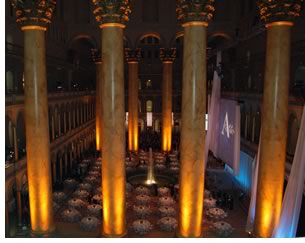 The
American Architectural Foundation, in partnership with the AIA, hosted
the 17th annual Accent on Architecture Gala February 10 in the soaring
Great Hall of the National Building Museum in Washington, D.C., a glorious
event that saw 1,000 architects and architecture champions unite to celebrate
the past, present, and future power of architecture “to enrich
and elevate the human spirit.”
The
American Architectural Foundation, in partnership with the AIA, hosted
the 17th annual Accent on Architecture Gala February 10 in the soaring
Great Hall of the National Building Museum in Washington, D.C., a glorious
event that saw 1,000 architects and architecture champions unite to celebrate
the past, present, and future power of architecture “to enrich
and elevate the human spirit.”
AAF President and CEO Ronald E. Bogle warmly welcomed guests and acknowledged this year’s sponsors of Accent on Architecture and spoke of the AIA’s upcoming sesquicentennial celebration in 2007 and the Foundation’s eagerness to lend support to that endeavor. AAF Board of Regents Chair Norbert W. Young, FAIA, and AIA President Kate Schwennsen, FAIA, then jointly introduced plans to create the “American Center of Architecture,” one of the major initiatives of AIA150, the AIA’s ongoing program to mark and celebrate its sesquicentennial.
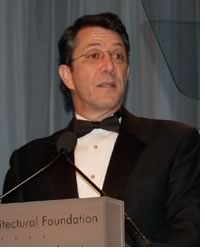 Schwennsen
explained that the American Center of Architecture is going to be both
a “place and a forum for new ideas,” and will
serve as the “future-looking counterpart to the celebration of
our past.” Young termed the American Center for Architecture program “one
of the most exciting ideas in years,” emphasizing that it draws
on the strengths of the AIA and the AAF. He noted that it will be designed
to enhance existing programs of both organizations and will strongly
emphasize sustaining the Octagon.
Schwennsen
explained that the American Center of Architecture is going to be both
a “place and a forum for new ideas,” and will
serve as the “future-looking counterpart to the celebration of
our past.” Young termed the American Center for Architecture program “one
of the most exciting ideas in years,” emphasizing that it draws
on the strengths of the AIA and the AAF. He noted that it will be designed
to enhance existing programs of both organizations and will strongly
emphasize sustaining the Octagon.
Schwennsen also introduced the 2006 Association of Collegiate Schools of Architecture/AIA Topaz Medallion recipient for excellence in architecture education William McGinn, FAIA. She then presented the AIA’s new Executive Vice President/CEO Christine McEntee, who assumed her new job on February 1. “I am honored to be here, and I consider myself most fortunate to have been selected as the AIA’s new CEO,” McEntee said. She acknowledged her immediate predecessor Norman L. Koonce, FAIA, for helping to set a firm foundation for the AIA and for helping her personally. McEntee noted that architects have a unique role to play in creating better, safer, more sustainable and beautiful environments. “There is a lot of work to do,” she said, “and this profession will step forward and do it.”
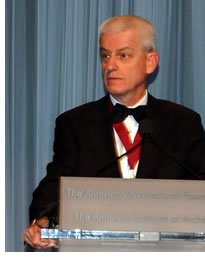 Pritzker family honored with AAF Keystone Award
Pritzker family honored with AAF Keystone Award
Young presented the 2006 American Architectural Foundation Keystone Award
to the philanthropic Pritzker Family of Chicago for their leadership
in advancing design excellence through their patronage and the creation
of the Pritzker Architecture Prize. Cindy Pritzker, with her late husband
Jay Pritzker, co-founded the Pritzker Architecture Prize in 1979. Their
eldest son, Thomas J. Pritzker, has become president of The Hyatt Foundation,
which was established to administer the prize. The Pritzker Prize honors
annually a living architect whose built work demonstrates a combination
of those qualities of talent, vision, and commitment that has produced
consistent and significant contributions to humanity and the built
environment through the art of architecture.
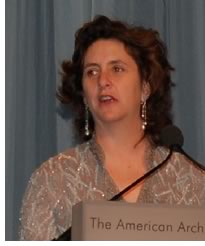 Accepting the Keystone Award on behalf of her family, Gigi Pritzker-Pucker
(daughter of Jay and Cindy), noted a similarity of purpose in the AAF
and the Pritzker Prize in promoting excellence in architecture. She outlined
the history of the award since its inception 27 years ago, recalling
the notable recipients and jurors—including inaugural jurors J.
Carter Brown, Hon. AIA; AIA Gold Medalist Cesar Pelli, FAIA; and J. Irwin
Cummins, Hon. AIA, founder of the Columbus, Ind., drive to hire great
American architects. “The jury makes the choices and we support
them,” she said. “The family does not interfere with the
process.” Pritzker offered her family’s profound gratitude
to the AAF for the Keystone Award.
Accepting the Keystone Award on behalf of her family, Gigi Pritzker-Pucker
(daughter of Jay and Cindy), noted a similarity of purpose in the AAF
and the Pritzker Prize in promoting excellence in architecture. She outlined
the history of the award since its inception 27 years ago, recalling
the notable recipients and jurors—including inaugural jurors J.
Carter Brown, Hon. AIA; AIA Gold Medalist Cesar Pelli, FAIA; and J. Irwin
Cummins, Hon. AIA, founder of the Columbus, Ind., drive to hire great
American architects. “The jury makes the choices and we support
them,” she said. “The family does not interfere with the
process.” Pritzker offered her family’s profound gratitude
to the AAF for the Keystone Award.
Thorncrown Chapel wins Twenty-five Year Award
The Thorncrown Chapel in Eureka Springs, Ark., has received the 2006
AIA Twenty-five Year Award for architectural design that has stood
the test of time for 25 years. The small but soaring glass and cross-braced
pine chapel, designed by the late AIA Gold Medalist E. Fay Jones, nestles
into an eight-acre woodland setting on a sloping hillside in the Ozark
Mountains. The tiny chapel, 24-foot-wide by 60-foot-long for a total
of 1,440 square feet—soars 48 feet to the sky. Its 425 windows,
made of 6,000 square feet of glass, filter woodland light across its
upward diamond-shaped pine trusses to form ever-changing patterns of
light and shadow throughout the day and night.
Robert A. Ivy, FAIA, Architectural Record editor in chief and author of Fay Jones, the seminal book about the architect and his works, brought the chapel into the Building Museum for the audience. “Thorncrown is elemental, a manmade temple,” he said. “This small building draws vistas with the primal force of truth.” Ivy recalled that the first Accent on Architecture celebration in 1990 honored Fay Jones as that year’s Gold Medalist. “His work continues to inspire and move us,” he noted.
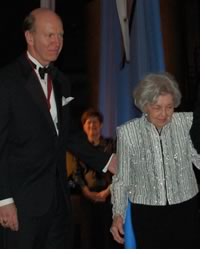 Mrs.
Fay Jones, known affectionately as “Gus,” received
the award. She recalled that shortly after construction of the chapel
was complete, Fay Jones had said, “This is going to be a pretty
nice little project but you know, no one is ever going to see it.
Mrs.
Fay Jones, known affectionately as “Gus,” received
the award. She recalled that shortly after construction of the chapel
was complete, Fay Jones had said, “This is going to be a pretty
nice little project but you know, no one is ever going to see it.
“I know that Fay would be so pleased to be included on a list with so many of his architectural heroes,” Mrs. Jones said. “I appreciate you honoring Thorncrown Chapel with the Twenty-five Year Award and in thanking all of you, I would like to quote Fay’s response when he received the AIA’s Gold Medal in Washington, February 22, 1990. He said, ‘This is a great moment in my life and to all of you who have made this so, I am truly grateful. Thank you very much.’”
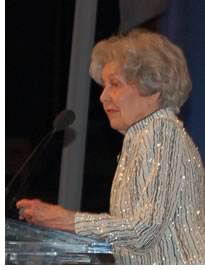 Architecture Firm Award to Moore Ruble Yudell
Architecture Firm Award to Moore Ruble Yudell
Schwennsen presented California’s Moore Ruble Yudell Architects & Planners
with the 2006 AIA Architecture Firm Award, the highest honor the AIA
bestows on an architecture firm. The Firm Award recognizes a practice
that consistently has produced distinguished architecture for at least
10 years. Robert Campbell, FAIA, Pulitzer Prize recipient and long-time
architecture critic for the Boston Globe, offered
his impressions of the 60-person firm and their work, which shows the
influences of the now-deceased AIA Gold Medalist Charles Moore, one its
founding partners. Campbell described the powerful sense of place created
in three of the firms most noted projects: St. Matthews Church; Tegel
Harbor, Berlin; and Tango Housing, Malmo, Sweden. He distilled the spirit
of their project down to three essences: “collaboration, color,
and making places.”
Buzz Yudell, FAIA, and John Ruble, FAIA, firm partners, accepted the award and brought their associates to the stage. “This is a wonderful and humbling experience,” said Yudell, thanking their firm and clients, as well as the AIA for fostering mentorships. He noted that working with the late and great Charles Moore was like being part of “a jazz ensemble. He encouraged improvisation.” Ruble spoke of the firm’s “enlightened clients” in the education, housing, and civic arenas. He also expressed gratitude toward the firm’s leadership and associates.
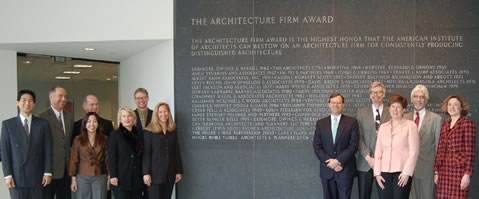
Predock accepts Gold Medal
As always, the crowning glory of the Accent on Architecture Gala comes
with the presentation of the AIA Gold Medal, conferred upon an individual
whose significant body of work has had a lasting influence on the theory
and practice of architecture. This year, that individual is Antoine
Predock, FAIA, master of the American West vernacular. In nominating
Predock for the award, Thomas S. Howorth, FAIA, AIA Committee on Design
Gold Medal Committee chair, explained: “Arguably, more than any
American architect of any time, Antoine Predock has asserted a personal
and place-inspired vision of architecture with such passion and conviction
that his buildings have been universally
embraced.”
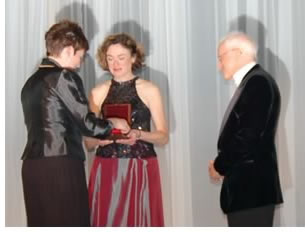 Washington
Post architecture
critic Benjamin Forgey, Hon. AIA, lauded Predock as “a fierce American
individualist,” and told the
audience that was one of the reasons for Predock being awarded the Gold
Medal. “Like Frank Lloyd Wright, he has developed a fiercely personal
view of architecture.” Forgey explained that he believes that the
essence of Predock’s “willfully and idiosyncratically
sculptural” architecture is that “he has discovered the process
of discovery. It is no accident that no two buildings of his look alike,
yet each is immediately identifiable as a Predock building.”
Washington
Post architecture
critic Benjamin Forgey, Hon. AIA, lauded Predock as “a fierce American
individualist,” and told the
audience that was one of the reasons for Predock being awarded the Gold
Medal. “Like Frank Lloyd Wright, he has developed a fiercely personal
view of architecture.” Forgey explained that he believes that the
essence of Predock’s “willfully and idiosyncratically
sculptural” architecture is that “he has discovered the process
of discovery. It is no accident that no two buildings of his look alike,
yet each is immediately identifiable as a Predock building.”
Schwennsen and McEntee presented the award to Predock, who seemed to admire the Gold Medal itself, then teasingly asked Schwennsen, “Kate, do I still have to do my learning units every year?” He then expressed his gratitude and paid homage to the people who have helped and inspired him throughout his career, beginning with Don Schlegel, FAIA, who as a young professor of engineering turned Predock toward architecture and “taught me always to be true to my inner life.” Asking his former professor to stand, Predock explained that Schlegel showed him that “it is possible for work to be—life. That is an extraordinary realization.”
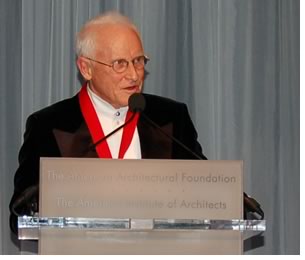 Predock
also expressed gratitude to his wife Constance, his coworkers, and associates
at his firm. He also praised his “fortunate panorama
of inspired clients” and asked them to stand and be recognized.
He then named many of the influences that have inspired his work, from
Frank Lloyd Wright to the Anasazi and Hopi cultures of the Southwest,
which have shown him that “we don’t have to learn only from
Europe. In the Southwest, we are most concerned with the movements of
the wind and the sun and the iconic landscape. It is all essence and
spirit—New Mexico does that to you.”
Predock
also expressed gratitude to his wife Constance, his coworkers, and associates
at his firm. He also praised his “fortunate panorama
of inspired clients” and asked them to stand and be recognized.
He then named many of the influences that have inspired his work, from
Frank Lloyd Wright to the Anasazi and Hopi cultures of the Southwest,
which have shown him that “we don’t have to learn only from
Europe. In the Southwest, we are most concerned with the movements of
the wind and the sun and the iconic landscape. It is all essence and
spirit—New Mexico does that to you.”
The 62nd Gold Medalist reminded the audience of the importance of peripheral vision: “Look to the sides for subtleties and nuances,” he advised. He spoke of “architecture as a dance” and the need to explore the tactile, perhaps through drawing and clay models that express the building’s life and can be “as liquid as a drawing. And, as wonderful as digital technology may be, that tactile quality must not be overwhelmed by the digital . . . The innocent mark is in all of us.”
Copyright 2006 The American Institute of Architects.
All rights reserved. Home Page ![]()
![]()
Photos, except as noted, by Douglas E. Gordon, Hon. AIA.
The American Architectural Foundation thanks the following for their generous support of the 2006 Accent on Architecture gala.
Principal Benefactor: McGraw-Hill Construction
Gala Sponsors: CNA/Victor O. Schinnerer Inc., Otis Elevator Company, Moore Ruble Yudell, Antoine Predock Architect, Deedie and Rusty Rose
Gala Benefactors: Armstrong, Brick Industry Association, CDC Publishing LLC, Forsgate Industrial Partners, Gensler, International Masonry Institute, Jacobs, National Energy Management Institute, Preston Gates Ellis & Rouvelas Meeds LLP, SOM, Thompson-Tomasetti Group, Turner Construction Company-Tompkins Builders, UNICO Inc., USG, WDG Architecture PLLC, Weidlinger Associates.
Gala Contributors: Academic Travel Abroad, Cawley Family Foundation, HKS Architects, Kaplan AEC Foundation, Leo A Daly, MBNA America, San Diego Padres, Thompson Ventulett Stainback & Associates Inc., TMA Resources.
Gala Friends: AIA Arizona; AIA Arkansas; AIA Minnesota; AIA New York Chapter; AIA New York State; AIA Portland Oregon; AIA Rhode Island; AIA South Carolina; AIA Tampa Bay; Beyer Blinder Belle Architects; Carton Donofrio Partners; Greenway Group; Greenwich Consulting; Harold Adams, FAIA, RIBA, JIA; Hellmuth Obata & Kassabaum; International Interior Design Association; Jane Wolford, PhD and Aron Wolford, Hon. AIA; JCJArchitecture; M&T Bank; Sasaki Associates; SmithGroup; Sterling Brands; Webcor; Zimmer Gunsul Frasca Partnership.
![]()